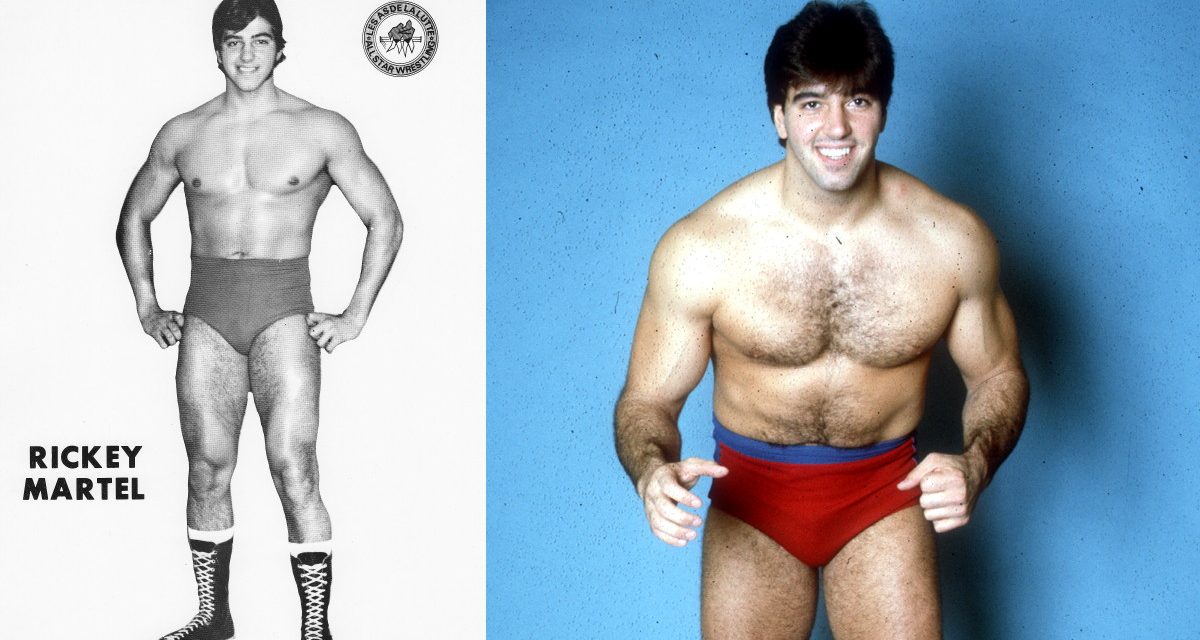There are few performers who have appeared in as many Wrestlemania events as Quebec’s Rick Martel. The former AWA title-holder — the 25th anniversary of which occurs in May — enjoyed no less than six such spectaculars, and it would have been seven, had his final tag team match at Wrestlemania X not be cancelled on the day due to time constraints.
Beginning at his first Wrestlemania, then — the record-breaking 1987 edition at the Pontiac Silverdone, during which he teamed with Tom Zenk (as the Can-Am Connection) to defeat Don Muraco and Bob Orton Jr. — SLAM! Wrestling took a stroll down memory lane with the man latterly known as “The Model”, to revisit what were largely fond memories of what he calls “the mother of all pay-per-views.” Babyface or heel, Martel saw Wrestlemania at its biggest in the 1980s, and as business began to hurt in the 1990s.
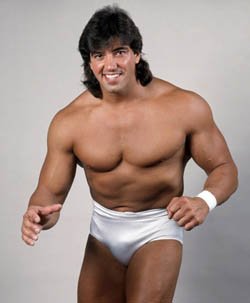
Three cheers for the good Rick Martel!
“I remember Wrestlemania III was the first time that wrestling really caught national attention in the States,” said Martel, in an interview conducted from his home in Quebec. “Everyone was saying, ‘What is this? What’s going on?’ and all the programs on national television would mention it. Everyone was talking about Wrestlemania III, all across the country. I think we were in Phoenix, maybe three or four weeks before the show, and this guy came in and started screaming that everything was sold out for Wrestlemania. We were all like kids (in the dressing room), because this was the first experience of something so huge for everybody.
“We flew in on the Saturday, the day before the event, and we went to the arena to do a couple of interviews at ringside, looked at all the chairs that were empty in that huge building. I said, ‘Wow, all of these seats are going to be full tomorrow!’, and of course, Tom Zenk and I opened up that Wrestlemania against Don Muraco and Bob Orton. That brought a little extra pressure, because you want to start things right, in the right mood. I remember that when I went in the ring, I didn’t look up — I just concentrated on my match and what was going on in the ring. And then, after the match was over, then I allowed myself to look up absorb the moment. I remember thinking that it would always be a great memory.”
Without this writer’s prompting, Martel then went on to note how much the main event of Hulk Hogan versus Andre the Giant, meant to everyone, and not just the two wrestlers. And he was finally able to put to rest the near-folklore story that no-one, not even Vince McMahon, knew if Andre was going to allow Hogan to defeat him on that day. Perhaps surprisingly, the tension in the locker room was very real indeed.
“That was very exciting for me, because both of these guys were friends of mine. When I was in the AWA, Hulk Hogan and I shared an apartment for a few months, so we were close friends. And Andre, of course, was French, and we would travel together when we were in the same towns. So I was friends with both of these guys, and I know what this match meant to both of them, in particular for Andre, who was passing on the torch of the superstar of wrestling to Hogan. I remember having goosebumps on several occasions as I watched this match, and I remember being very glad to have been a part of it, and to be able to witness it all.
“And it’s true, there was definitely tension backstage (as to whether Andre would take the fall for Hogan). In fact, I remember Hulk talking to me about it. Andre was Andre, you know, he was a giant (laughs). He did whatever he wanted to do, whenever he wanted to do it, and no-one would stop him. There was tension between Andre and Hogan for a few months before that, because Andre had a lot of pride in being the main attraction in wrestling, and all of a sudden here was Hulk Hogan, the new man in wrestling and even in Hollywood. Before, Andre was the main wrestler they used for different projects in the movies, and wrestling was all about Andre. And Andre did not care for Hulk at first — he saw him as a threat to his status as the king of wrestling.
“But at some point in that day, Andre decided that there was nothing that he could do about it, that that was life, and that it was Hulk’s time to be the main guy. He accepted it, and they had a fantastic match, especially since Andre was in tremendous pain, with his lower back hurting him quite a bit. When he went out to the ring he was in bad shape, and when he came back from the ring he was in even worse shape. So no-one knew, not even Vince, what was going to happen. We were all hoping that things were going to go right, but no-one knew for sure.”
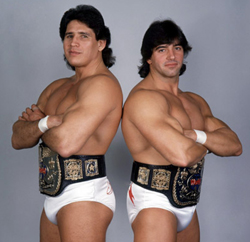
Strike Force! Martel and Santana
Wrestlemania IV was the beginning of a two-year run for the event at Donald Trump’s Trump Plaza in Atlantic City, New Jersey, and likewise, Martel would be involved in headline matches on both Wrestlemania IV and V, as he teamed with Tito Santana (as Strike Force) to face Demolition (Ax and Smash) and The Brain Busters (Arn Anderson and Tully Blanchard) respectively. Ironically, the loss of the WWF Tag Team Titles at Wrestlemania IV was the springboard for the most memorable run of Martel’s New York career, as a heel post-Wrestlemania V.
“We were really happy to be the penultimate match at Wrestlemania IV (before the main event of Ted DiBiase and Randy Savage),” Martel noted. “Teaming up with Tito then was fantastic, and I already had a lot of respect for him as I had met him in the AWA, and knew he was a great wrestler. I really enjoyed being with him as a partner. And no doubt about it, I preferred wrestling with Santana much more than I did with Tom Zenk.
“Wrestlemania V, of course, is where I became ‘The Model,’ and I remember before that match in Atlantic City, a lot of people didn’t agree with what I wanted to do. Vince, for example, didn’t think that I was going to be able to pull it off. But when I walked out of the ring that day (having left partner Santana to battle Anderson and Blanchard single-handedly), and the reaction was instant, with the people already booing me. And the first person that came to me in the dressing room was Hulk, who told me that I had got a great reaction, and that he thought I’d accomplished it. The next day we were doing television in up-state New York, and when I went out to the ring, the reaction was there, and the people really accepted the fact that I was going to be a heel. That was great, I really enjoyed that.
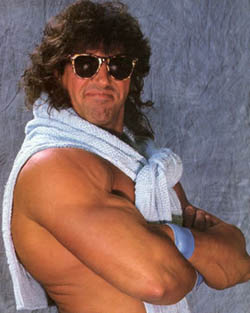
Let the boos rain down on The Model!
“I had been a babyface for 15 years, and I wanted a change,” he said of the switch. “I had mentioned that to Vince on a couple of occasions, and he had always told me, ‘No, Rick, the people like you too much. I just don’t see you as a heel.’ I think the second time that I asked, Macho Man was in the middle of doing it, and Vince said that it didn’t make sense to do it at the same time, in case one would take from the other. So finally, I said, ‘Let me go heel, or I’m leaving.’ So we sat down and had a really serious talk about it, and he finally agreed to give it a try.
“I knew that I wanted to become a heel, but I didn’t know if there was a particular gimmick out there that I wanted to do,” he continued. “So JJ Dillon suggested the idea of ‘The Model’ to Vince, and he loved it. But when they mentioned it to me, I really wasn’t sure if I was going to be able to pull that off. I called my wife and told her what they had come up with for me, and her first reaction was to say, ‘Well, just be thankful they didn’t call you a Red Rooster!’ (laughs) After that, I just set my concentration on getting the thing over, thinking about the catwalk, and the ‘Arrogance’ perfume. And Vince gave me the green light on everything I came up with. I was really happy with the result.”
After an opening match win over Koko B. Ware at Wrestlemania VI — Martel’s position on the card largely due to being on the comeback trail from a shoulder injury suffered in a bout with Hercules Hernandez — the following year saw Martel in one of the most famous gimmick matches in Wrestlemania history, the “Blindfold Match” against the incomparable Jake “The Snake” Roberts at Wrestlemania VII in Los Angeles.
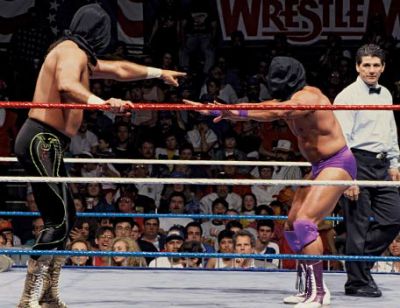
Jake Roberts and Rick Martel at Wrestlemania VII under their blindfolds. Photo courtesy www.rickthemodelmartel.com
“My first reaction (to the idea of a Blindfold match) was, ‘What am I going to do with that?!’ (laughs) I had never been in a blindfold match before, and also, I didn’t like the idea of wrestling with my vision obscured even a little bit, because injuries can happen. But Jake had done it before, and he was sure that things would go well, and Vince came to us anyway and told us that we have a run at the match a month before in West Palm Beach, Florida. There, the reaction was great, and even though I couldn’t see much, we pulled out it off, and I was confident that by the time Wrestlemania came, I was going to be better at it. And when we actually had the match in Los Angeles, it was great.”
Of much greater overall note than any of the matches themselves — including, even, the much-maligned, Gulf War-inspired Hulk Hogan versus Sgt. Slaughter bout — was the fact that Wrestlemania VII was originally planned as an 100,000 fan spectacular at the Los Angeles Coliseum, before being hastily re-scheduled to take place at the nearby Sports Arena. The official reason at the time was that a bomb threat had been issued on the back of the poor-taste Slaughter angle, but poor ticket sales were the true cause. Martel, however, says that the change of venue was no concern for the performers themselves.
“At the point that Wrestlemania VII came around, I don’t think we could have expected to have a really big event. We were working so much, we were so concentrated on that — we were like machines (laughs). As far as I was concerned anyway, I trusted Vince. I think we knew that he would do what would be best for the wrestling profession, and we trusted him fully. It makes a difference when you have a bigger event, when you have a bigger venue, with the bigger crowds. But we were still happy with everything. I don’t recall anyone making a scene, or having any conversations, or anyone making a big deal out of it.”
Following a self-imposed hiatus following the match with Roberts, Martel enjoyed another Wrestlemania moment at the Hoosier Dome in Indianapolis at Wrestlemania VIII, as he faced the recently-debuted Tatanka, who the company were banking on as a star of the future. It was to be Martel’s final Wrestlemania appearance, the reasons for which he completely understood.
“At that time, my interests were really divided in half. I knew that wrestling was not going to be a part of my life forever, and I knew I had to branch out and do something else before I became too dependent on wrestling. You know, we don’t have insurance or a union — we have to depend strictly on your own, and if you’re injured, too bad. So when I took a year off after the match with Jake, I started studying commercial real estate, got into it, and had some great opportunities. Once that got started, then I came back into wrestling. But I soon realized one thing; if you want to be the best in wrestling, you have to be at it 100%, and I was only at it 50-50 at that point. I used to go on the road, and when I’d come back home, I’d get involved with the real estate projects that I wanted to. My mind wasn’t in wrestling 100%.
“And in all fairness, Vince knew it. He knew the difference. He knew what I could do at 100%, and he knew that I wasn’t there. So although I wasn’t bitter, my pride was hurt, and it was hard for me to accept that I couldn’t have it both ways. But I accepted that, and to this day I don’t regret the decision. I’m very thankful for my second career, and for having a good life now.
The Wrestlemania VIII loss may have been Martel’s last in-ring performance at the event, but it would not have been had time been on his side. After yet another hiatus — once more caused by his outside business ventures — he returned in late 1993, and thus found himself announced for the card of Wrestlemania X, where he was due to team with The Headshrinkers (Samu and Fatu), I.R.S, and Jeff Jarrett, to battle The 1-2-3 Kid, The Smoking Gunns (Billy and Bart Gunn), and “Sparky” Plugg (Bob Holly). Unfortunately for all concerned, the match was cancelled when other matches over-ran.
“I was disappointed, of course,” said Martel. “But I was more disappointed for the other guys, because I remember that there were a lot of rookies in the match, and some of them had their families there to see them in Madison Square Garden. It was their first Wrestlemania, and they were excited to the max. I was disappointed to a point, but I had been in a few Wrestlemanias. I wanted to be in there for sure, but I didn’t make a big deal out of it.”
In truth, it was hardly a decorous end to a Wrestlemania career that gave so much, even if, in storyline terms, those performances only led to two wins in six appearances. But unlike his peers Roddy Piper, Jimmy Snuka, and Ricky Steamboat — all of whom appear to be involved physically in Chris Jericho’s match at WrestleMania 25 — there’s no going back for Martel, who is quite certain that he’ll never step into the ring again, even for an event as large as Wrestlemania.
“No, definitely not — I retired in 1998,” he concluded. “I loved it, I loved wrestling, but I’m not going to make a comeback. Not long ago I did a thing with Tony Garea at the Night of Champions, and as we went to the ring and the reaction was great, and when I took off my jacket, I loved it! The energy and adrenaline you get from the people — it was fantastic. It revived a lot of old memories in me that I thought were gone 10 years after my retirement.
“Right after that, people came and asked me, ‘Well, how about it?’ (wrestling another match). I thought, ‘Yeah, I’d love to, it would be fun!’ but then five minutes later I thought, ‘Nah, I don’t think so” (laughs). The idea of it sounds good, but me, back in the ring, I don’t think that I would like that.”
RELATED LINK
